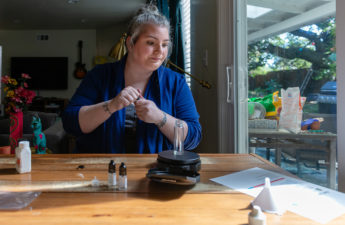The U.S. Centers for Disease Control and Prevention [CDC] has found an additive called vitamin E acetate in the lung fluid of 29 of 29 patients who underwent a procedure called called bronchoalveolar lavage.(BAL).
The CDC reports:
Recent CDC laboratory testing of bronchoalveolar lavage (BAL) fluid samples (or samples of fluid collected from the lungs) from 29 patients with EVALI submitted to CDC from 10 states found vitamin E acetate in all of the BAL fluid samples.
Vitamin E acetate is used as an additive in the production of e-cigarette, or vaping, products. This is the first time that we have detected a potential chemical of concern in biologic samples from patients with these lung injuries.
CDC continues to recommend that people should not use e-cigarette, or vaping, products that contain THC, particularly from informal sources like friends, or family, or in-person or online dealers. We will continue to provide updates as more data become available.What We Know
New Laboratory Findings:
- Analyses of bronchoalveolar lavage (BAL) fluid samples (or samples of fluid collected from the lungs) of patients with e-cigarette, or vaping, product use associated lung injury identified vitamin E acetate, an additive in some THC-containing products.
- Recent CDC laboratory test results of BAL samples from 29 patients submitted to CDC from 10 states identified vitamin E acetate in all BAL fluid samples. THC was identified in 82% of the samples and nicotine was identified in 62% of the samples.
- CDC tested for a range of other chemicals that might be found in e-cigarette, or vaping, products, including plant oils, petroleum distillates like mineral oil, MCT oil, and terpenes (which are compounds found in or added to THC products). None of these potential chemicals of concern were detected in the BAL fluid samples tested.
- This is the first time that we have detected a potential chemical of concern in biologic samples from patients with these lung injuries. These findings provide direct evidence of vitamin E acetate at the primary site of injury within the lungs.
- These findings complement the ongoing work of FDAexternal icon and some state public health laboratories to characterize e-liquid exposures and inform the ongoing multistate outbreak.
About the Outbreak:
- As of November 5, 2019, 2,051 cases of e-cigarette, or vaping, product use associated lung injury (EVALI) have been reported to CDC from 49 states (all except Alaska), the District of Columbia, and 1 U.S. territory.
- Thirty-nine deaths have been confirmed in 24 states and the District of Columbia (as of November 5, 2019).
- Latest outbreak information is updated every Thursday.
- CDC continues to work closely with FDA, states, public health partners, and clinicians on this investigation.
About Patient Exposure:
- All EVALI patients have reported a history of using e-cigarette, or vaping, products.
- THC is present in most of the samples tested by FDA to date, and most patients report a history of using THC-containing products.
- The latest national and state findings suggest products containing THC, particularly from informal sources like friends, or family, or in-person or online dealers, are linked to most of the cases and play a major role in the outbreak.
What We Don’t Know
- No one compound or ingredient has emerged as the cause of these illnesses to date; and it may be that there is more than one cause of this outbreak. Many different substances and product sources are still under investigation.
- While it appears that vitamin E acetate is associated with EVALI, evidence is not yet sufficient to rule out contribution of other chemicals of concern to EVALI.
What CDC Recommends
- CDC recommends that you do not use e-cigarette, or vaping, products that contain THC.
- CDC also recommends that people should not:
- Buy any type of e-cigarette, or vaping, products, particularly those containing THC, off the street.
- Modify or add any substances to e-cigarette, or vaping, products that are not intended by the manufacturer, including products purchased through retail establishments.
- Since the specific compound or ingredient causing lung injury are not yet known, the only way to assure that you are not at risk while the investigation continues is to consider refraining from use of all e-cigarette, or vaping, products.
- Adults using e-cigarettes to quit smoking should not go back to smoking; they should weigh all risks and benefits and consider utilizing FDA-approved nicotine replacement therapiesexternal icon..
- If people continue to use an e-cigarette, or vaping, product, carefully monitor yourself for symptoms and see a healthcare provider immediately if you develop symptoms like those reported in this outbreak.
- Irrespective of the ongoing investigation:
- E-cigarette, or vaping, products should never be used by youths, young adults, or women who are pregnant.
- Adults who do not currently use tobacco products should not start using e-cigarette, or vaping, products. There is no safe tobacco product. All tobacco products, including e-cigarettes, carry a risk.
- THC use has been associated with a wide range of health effects, particularly with prolonged heavy use. The best way to avoid potentially harmful effects is to not use THC, including through e-cigarette, or vaping, products. Persons with marijuana use disorder should seek evidence-based treatment by a health care provider.


